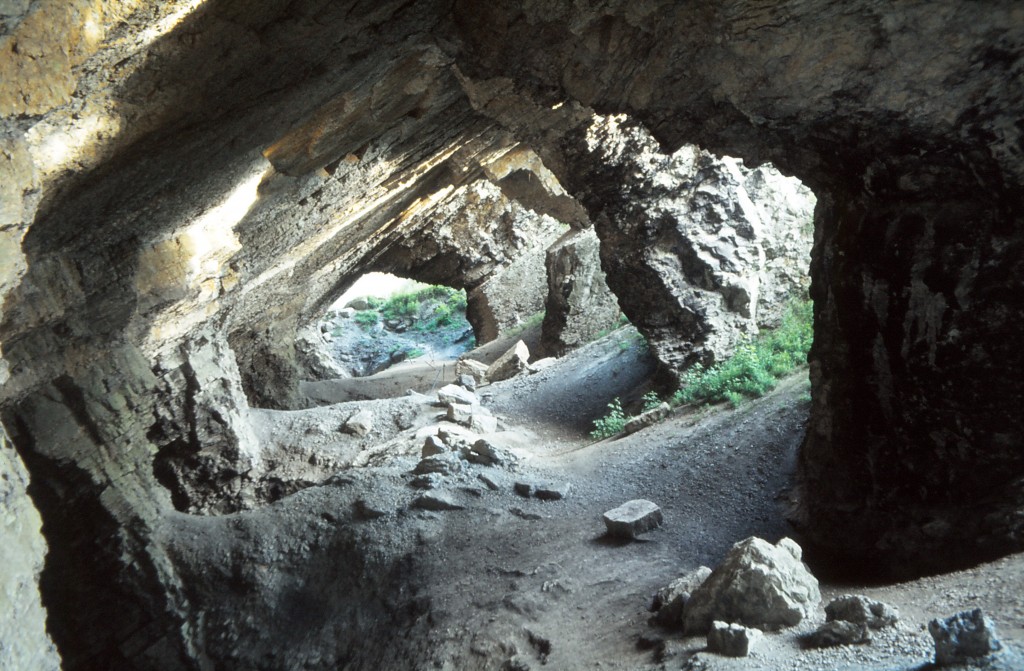Wren’s Nest National Nature Reserve
Stratigraphy and Status
Wren’s Nest and Castle Hill contain superb exposures of middle Silurian (Wenlock and lower Ludlow series) rocks, including a definitive section through the Much Wenlock Limestone Formation. Around and between the hills lie Middle Carboniferous (Westphalian) strata, including the South Staffordshire Thick Coal; at 9-12.8 metres, the thickest coal seam in the British Isles. Wren’s Nest was designated Britain’s first National Nature Reserve for geology in 1956. It is a superb educational site, particularly for teaching the principles of stratigraphy and palaeoecology.
Superlative Geological Phenomena
The Wenlock Limestone of Dudley contains the most diverse and abundant fossil fauna in the British Isles: over 600 species of marine invertebrate, representing some 29 major taxonomic groups. The Wenlock Limestone of Dudley is a fossil lagerstatten, containing rare and important life assemblages, in the form of beds of articulated crinoids (sea lilies) superbly preserved under deposits of terrigenous mud and volcanic clay. Rare annelid and early plant remains have been found, containing soft tissue. The site is the type locality for 186 species of fossil; more than any other British site). 63 of these are recorded nowhere else. Many new taxa, particularly of microfossils, have yet to be described. Dudley’s fossils are among the most perfectly preserved Silurian fossils in the world. This is reflected in the fact that they have always been highly valued and are found in countless museum collections and displays across the globe. Other superlative features of the site include bioherms (fossil ‘patch’ reefs preserved ‘in situ’), and expansive ripple beds, which provide evidence of littoral zone conditions.
Matt’s Maps

The stratigraphic column, map and section have been kindly provided by BCGS member Matt Sutton. (2021)


See BCGS Newsletter 265 for Matt’s full article.
Dudley’s Association with Events, Ideas and Beliefs
The strata of Wren’s Nest and Castle Hill were cited by 19th century geologist Sir Roderick Murchison, to help define the Wenlock series in his seminal work The Silurian System (1839). 65% of the Wenlock fossil species described and figured by Murchison in The Silurian System were from Dudley. Wenlock fossils from Dudley are figured in hundreds of scientific and popular publications including monographs and treatise. Abraham Darby, father of the Industrial Revolution, was born on Wren’s Nest in 1678, and raised on the hill. A forerunner of Darby’s coking process, (the conversion of coal into coke to fuel the iron furnaces), was developed earlier (in the 1620s) by Dud Dudley, illegitimate son of the local Earl. His work was abandoned however, due to violent protests from local charcoal burners who feared their livelihoods may be threatened.
Geology and its Exploitation by Man
The rocks of Castle Hill, Wren’s Nest and their surrounds provided the raw materials to establish Dudley as the centre of what became known as the ‘Black Country’, the Cradle of the Industrial Revolution. The juxtaposition of materials for the manufacture of iron – coal, ironstone and limestone, together with fireclay are unique to the area.

Seven Sisters Cavern at the Wren’s Nest, 1984. Photo by Peter Parkes
Limestone mining has left a spectacular legacy of quarries and caverns, including Dark Cavern, Britain’s largest man-made limestone cavern. The caverns were linked by subterranean canal tunnels, which are unique to Dudley. These were connected to the national canal system by the Dudley Tunnel, the earliest narrowboat canal tunnel in the world. Built in 1785 and just over a mile long, it cuts the English watershed and when first built was the longest canal tunnel in England.
The Newcomen ‘Atmospheric’ Engine, the world’s first commercial steam engine, was erected near Castle Hill in 1712. It pumped water from coal mines allowing miners to excavate from ever increasing depths and led to further development with steam power. This includes the work of Richard Trevithick, James Watt, William Murdock and George Stephenson.
Geology and Social History
The trilobite fossil Calymene blumenbachii is so common in the local rocks that it was adopted as the symbol of the limestone mining industry and appeared in the centre of the town’s coat of arms. It is more widely known by its nickname the ‘Dudley Locust’ or ‘Dudley Bug’.
Murchison visited Dudley in 1839 and 1849 to address members of the British Association inside Dark Cavern – by gaslight. An estimated 15,000 people attended each event, with Murchison being acclaimed ‘King of Siluria’ at Wren’s Nest. These remarkable events have since become part of both local and scientific ‘lore’.
The Black Country Museum which stands within the proposed World Heritage Site celebrates the industrial past of the region. Built on the site of 18th century collieries and at the entrance to the underground canal system, it utilises some of the original industrial features including buildings, mine shafts, giant lime kilns, canal basins and tunnels.
Dudley Museum and Art Gallery maintains a definitive collection of fossils from Wren’s Nest and Castle Hill. This collection was established following the publication of The Silurian System and boasts specimens figured by Murchison.
Guide Books and Leaflets
Download the text from 1990 Wren’s Nest Geological Handbook and Field Guide, (PDF 196KB).
Download 2005 Wrens Nest NNR Leaflet, (PDF 1,156KB).
Download 2009 Wrens Nest NNR Leaflet, (PDF 1,395KB).
Download Geology of Wren’s Nest, Geopark leaflet, (PDF 663KB).
Black Country Geopark
Wren’s Nest National Nature Reserve is one of the Black Country Geopark’s Geosites.

